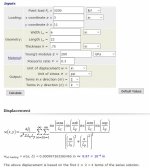Not sure I understand this. The vertical motor drives a 4 story-long shaft that runs a pump. There is a coupling on the bottom of the motor, with some shim between it and the long transmission shaft. The transmission shaft goes through a 19" hole below the motor. The motor has at least two bearings. The bottom one is radial service only, and slides up and down in a sleeve. The top has at least one bearing, a thrust bearing. This bearing supports the armature weight. Its purely a thrust bearing, so we will assume that there's another sliding radial bearing at the top of the armature shaft. There is no clearance for a crane on top, and other factors (such as the electrical service box placement) make any process of creating clearance impractical. You want to disconnect the bottom coupling from the long transmission shaft, and loosen the coupling and slide it up the shaft, leaving a space between the end of the armature and the long transmission shaft. You wish to use that space to put in a "beam" made of 3/4 steel, 6 inches wide by 22 inches long. Using the surface where the 19" hole is as a support, you wish to jack the "beam" up, which you hope will lift the 3200lb armature. As I understand it, you wish to lift it enough so that you can inspect the thrust bearings that usually support the armature. If they are knackered (as you suspect that they are), you'll need to remove a coupling from the top (while supporting the armature from below), and will replace the thrust bearings (and perhaps the radial ones? - I'd think you only one to pull this stunt once in your lifetime). Then you replace the top coupling, lower the armature, test it to ensure it runs properly, and then you can loosen the lower coupling, slide it down to mate with the long transmission shaft, and then make secure the couple.
Yes?
My only suggestion would be to make the plate wider if you can. Makes it heavier and less easy to sling around, but an 8 inch or 10 inch wide plate will flex less.
That said, this efunda page gave me a displacement of about 0.001 inch under your load condition. I may have done it wrong, however - the drawing is not clear I think. Page is here:
http://www.efunda.com/formulae/solid_mechanics/plates/calculators/SSSS_PPoint.cfm#Results
Inputs I used are below.
View attachment 194671


